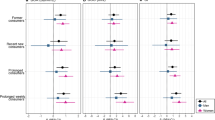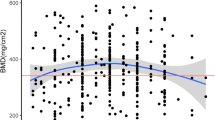Abstract
Objectives
Previous studies found that tea consumption was related to a reduction in the risks of some chronic diseases, but limited data are available on bone health. This study aimed to examine the associations of tea consumption with hip bone strength in Chinese women.
Design
Cross-sectional study.
Setting
The participants were from the ongoing Guangzhou Nutrition and Health Study. This was a cohort study started in 2008. The examination data conducted between June 2010 and December 2013 were used.
Participants
A total of 1,495 Chinese women aged more than 40 years were included.
Measurements
Tea consumption, sociodemographic information and lifestyle habits were collected by a face-to-face questionnaire. Hip bone mineral density (BMD) and geometric parameters, i.e. cross-sectional area (CSA), section modulus (Z) and buckling ratio (BR), were generated by dual-energy X-ray absorptiometry. The associations of tea consumption with bone phenotypes were detected by analysis of covariance and multiple linear regression models after adjusting for age, body mass index, years since menopause, physical activity, dietary-protein intake, dietary-calcium intake, calcium tablet intake, drinking status and smoking status.
Results
Tea drinkers (n = 732) had approximately 1.9% higher BMD (p < 0.05) and 3.6% lower BR (p < 0.05) than non-tea drinkers (n = 763). The dose-response relationships of BMD, BR or CSA with total tea consumption were identified (p-trend < 0.05). Tea drinking was found to be a significant and independent predictor of BMD (β = 0.068, p < 0.05) or BR (β = -0.079, p < 0.05).
Conclusion
Tea consumption was associated with increased bone strength in middle-aged and elderly Chinese women.

Similar content being viewed by others
References
Looker AC, Johnston CJ, Wahner HW, et al. Prevalence of low femoral bone density in older U.S. women from NHANES III. J Bone Miner Res. 1995; 10(5): 796–802.
Li GW, Chang SX, Xu Z, Chen Y, Bao H, Shi X. Prediction of hip osteoporotic fractures from composite indices of femoral neck strength. Skeletal Radiol. 2013; 42(2): 195–201.
LaCroix AZ, Beck TJ, Cauley JA, et al. Hip structural geometry and incidence of hip fracture in postmenopausal women: what does it add to conventional bone mineral density? Osteoporosis Int. 2010; 21(6): 919–929.
Kaptoge S, Beck TJ, Reeve J, et al. Prediction of Incident Hip Fracture Risk by Femur Geometry Variables Measured by Hip Structural Analysis in the Study of Osteoporotic Fractures. J Bone Miner Res. 2008; 23(12): 1892–1904.
Yang CS, Hong J. Prevention of Chronic Diseases by Tea: Possible Mechanisms and Human Relevance. Annu Rev Nutr. 2013; 33: 161–181.
Sanga S, Lambertb JD, Hoc C, Yang CS. The chemistry and biotransformation of tea constituents. Pharmacol Res. 2011; 64(2): 87–99.
Zhao M, Zhang D, Su X, et al. An Integrated Metagenomics/Metaproteomics Investigation of the Microbial Communities and Enzymes in Solid-state Fermentation of Pu-erh tea. Sci Rep. 2015; 5: 10117.
Feng L, Chong MS, Lim WS, et al. Tea Consumption Reduces the Incidence of Neurocognitive Disorders: Findings from the Singapore Longitudinal Aging Study. J Nutr Health Aging. 2016; 20(10): 1002–1009.
Yang J, Mao QX, Xu HX, Ma X, Zeng CY. Tea consumption and risk of type 2 diabetes mellitus: a systematic review and meta-analysis update. BMJ Open. 2014; 4(7): e5632.
Liu J, Liu S, Zhou H, et al. Association of green tea consumption with mortality from all-cause, cardiovascular disease and cancer in a Chinese cohort of 165,000 adult men. Eur J Epidemiol. 2016; 31(9): 853–865.
Butt MS, Ahmad RS, Sultan MT, Qayyum MM, Naz A. Green tea and anticancer perspectives: updates from last decade. Crit Rev Food Sci Nutr. 2015; 55(6): 792–805.
Shen CL, Chyu MC, Wang JS. Tea and bone health: steps forward in translational nutrition. Am J Clin Nutr. 2013; 98(6): 1694S–1699S.
Nash LA, Ward WE. Tea and Bone Health: Findings from Human Studies, Potential Mechanisms, and Identification of Knowledge Gaps. Crit Rev Food Sci. 2015: 00-00.
Wang G, Liu LH, Zhang Z, et al. Oolong Tea Drinking Could Help Prevent Bone Loss in Postmenopausal Han Chinese Women. Cell Biochem Biophys. 2014; 70(2): 1289–1293.
Chen Z. Habitual Tea Consumption and Risk of Osteoporosis: A Prospective Study in the Women’s Health Initiative Observational Cohort. Am J Epidemiol. 2003; 158(8): 772–781.
Hamdi KI, Aydin S, Gemalmaz A, et al. Habitual tea drinking and bone mineral density in postmenopausal Turkish women: investigation of prevalence of postmenopausal osteoporosis in Turkey (IPPOT Study). Int J Vitam Nutr Res. 2007; 77(6): 389–397.
Saitoglu M, Ardicoglu O, Ozgocmen S, Kamanli A, Kaya A. Osteoporosis Risk Factors and Association with Somatotypes in Males. Arch Med Res. 2007; 38(7): 746–751.
Hernandez-Avila M, Stampfer MJ, Ravnikar VA, et al. Caffeine and other predictors of bone density among pre-and perimenopausal women. Epidemiology (Cambridge, Mass.). 1993; 4(2): 128–134.
Cao Y, Wang C, Guan K, Xu Y, Su Y, Chen Y. Association of magnesium in serum and urine with carotid intima-media thickness and serum lipids in middle-aged and elderly Chinese: a community-based cross-sectional study. Eur J Nutr. 2016; 55(1): 219–226.
Beck TJ. Extending DXA beyond bone mineral density: understanding hip structure analysis. Curr Osteoporos Rep. 2007; 5(2): 49–55.
Esenyel M, Ozen A, Esenyel CZ, Rezvani A, Sariyildiz MA, Ergin O. Hip Structural Changes and Fracture Risk in Osteopenia and Osteoporosis. The Eurasian Journal of Medicine. 2011; 43(2): 73–78.
Zhang CX, Ho SC. Validity and reproducibility of a food frequency Questionnaire among Chinese women in Guangdong province. Asia Pac J Clin Nutr. 2009; 18(2): 240–250.
Yang YX, Wang GY, Pan XC. China food composition tables. 1st ed. Beijing: Peking University Medical Press; 2002.
Wang P, Chen Y, He L, et al. Association of Natural Intake of Dietary Plant Sterols with Carotid Intima–Media Thickness and Blood Lipids in Chinese Adults: A Cross-Section Study. PLoS ONE. 2012; 7(3): e32736.
Gnudi S, Sitta E, Fiumi N. Bone density and geometry in assessing hip fracture risk in post-menopausal women. Br J Radiol. 2007; 80(959): 893–897.
Chen C, Kang L, Lin R, et al. (-)-Epigallocatechin-3-gallate improves bone microarchitecture in ovariectomized rats. Menopause. 2013; 20(6): 687–694.
Ng TP, Aung KC, Feng L, Feng L, Nyunt MS, Yap KB. Tea consumption and physical function in older adults: a cross-sectional study. J Nutr Health Aging. 2014; 18(2): 161–166.
Shen CL, Chyu MC, Yeh JK, et al. Effect of green tea and Tai Chi on bone health in postmenopausal osteopenic women: a 6-month randomized placebo-controlled trial. Osteoporosis Int. 2012; 23(5): 1541–1552.
Hegarty VM, May HM, Khaw KT. Tea drinking and bone mineral density in older women. Am J Clin Nutr. 2000; 71(4): 1003–1007.
Wu C, Yang Y, Yao W, Lu F, Wu J, Chang C. Epidemiological Evidence of Increased Bone Mineral Density in Habitual Tea Drinkers. Arch Intern Med. 2002; 162(9): 1001–1006.
Devine A, Hodgson JM, Dick IM, Prince RL. Tea drinking is associated with benefits on bone density in older women. Am J Clin Nutr. 2007; 86(4): 1243–1247.
Jin P, Wu H, Xu G, Zheng L, Zhao J. Epigallocatechin-3-gallate (EGCG) as a proosteogenic agent to enhance osteogenic differentiation of mesenchymal stem cells from human bone marrow: an in vitro study. Cell Tissue Res. 2014; 356(2): 381–390.
Wu CH, Yang YC, Yao WJ, Lu FH, Wu JS, Chang CJ. Epidemiological evidence of increased bone mineral density in habitual tea drinkers. Arch Intern Med. 2002; 162(9): 1001–1006.
Cabrera C, Giménez R, López MC. Determination of Tea Components with Antioxidant Activity. J Agr Food Chem. 2003; 51(15): 4427–4435.
Das AS, Mukherjee M, Das D, Mitra C. Protective Action of Aqueous Black Tea (Camellia sinensis) Extract (BTE) against Ovariectomy-induced Oxidative Stress of Mononuclear Cells and its Associated Progression of Bone Loss. Phytother. Res. 2009; 23(9): 1287–1294.
Zhang X, Wu Z, Weng P. Antioxidant and Hepatoprotective Effect of (-)-Epigallocatechin 3-O-(3-O-Methyl) gallate (EGCG3-Me) from Chinese Oolong Tea. J Agr Food Chem. 2014; 62(41): 10046–10054.
Zhang L, Zhang Z, Zhou Y, Ling T, Wan X. Chinese dark teas: Postfermentation, chemistry and biological activities. Food Res Int. 2013; 53(2): 600–607.
Author information
Authors and Affiliations
Corresponding authors
Rights and permissions
About this article
Cite this article
Huang, H., Han, GY., Jing, LP. et al. Tea consumption is associated with increased bone strength in middle-aged and elderly Chinese women. J Nutr Health Aging 22, 216–221 (2018). https://doi.org/10.1007/s12603-017-0898-z
Received:
Accepted:
Published:
Issue Date:
DOI: https://doi.org/10.1007/s12603-017-0898-z




